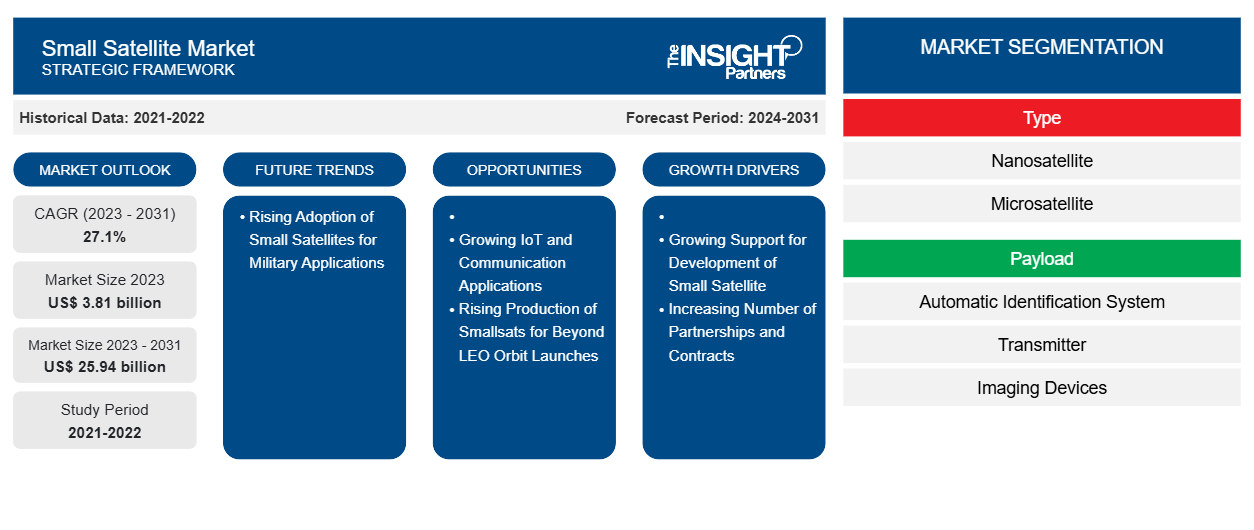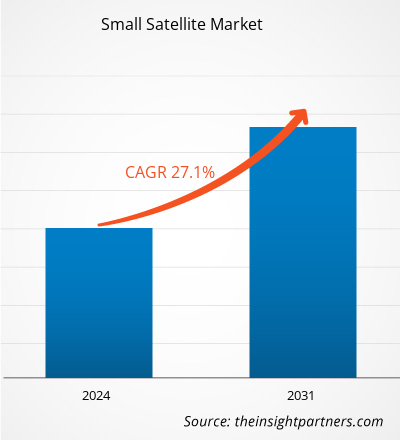The Small Satellite Market size is projected to reach US$ 25.94 billion by 2031 from US$ 3.81 billion in 2023. The market is expected to register a CAGR of 27.1% in 2023–2031. The rising adoption of small satellites for military applications is likely to remain a key small satellite market trend.
Small Satellite Market Analysis
Many start-ups in the small satellite market have witnessed a decline in their business growth and operations due to several challenges due to the onset of the pandemic, including delays in satellite launch projects and product deliveries owing to supply chain challenges and minimal investments in the small satellite sector. Further, the growth in the development of nanosatellites with the help of investments across the small satellite industry for future constellation launch projects is also boosting the business growth of small satellite ecosystem vendors. This growth is mainly due to the increase in demand for smallsat components such as sensors, transmitters, imaging devices, transponders, antennas, automatic identification systems, etc., for small satellite production.
Small Satellite Market Overview
The small satellite manufacturers offer a wide range of satellites such as pico satellites, nanosatellites, and microsatellites. These satellites are used for various applications, including earth observation, communication & navigation, and scientific research. Additionally, the increasing demand for satellite-based service offerings from the commercial and military sectors is further influencing the demand for small satellites. A few of the major players operating in the global small satellite market are Northrop Grumman Corporation, L3Harris Technologies Inc., Thales Group, Millennium Space Systems Inc. (a Boeing Company), Space Exploration Technologies Corp. (SpaceX), and Surrey Satellite Technology Ltd.
Customize This Report To Suit Your Requirement
You will get customization on any report - free of charge - including parts of this report, or country-level analysis, Excel Data pack, as well as avail great offers and discounts for start-ups & universities
Small Satellite Market: Strategic Insights

-
Get Top Key Market Trends of this report.This FREE sample will include data analysis, ranging from market trends to estimates and forecasts.
Small Satellite Market Drivers and Opportunities
Increasing Number of Partnerships and Contracts
The growing need for small satellites encourages market players to make strategic partnerships, collaborations, and contracts. A few strategies by the players are mentioned below:
- In April 2022, NASA awarded a contract of US$ 280 million to SATCOM companies to develop near-Earth space communication services. Under this contract, Elon Musk's Space Exploration Technologies is awarded the largest amount of US$ 69.95 million, followed by Kuiper Government Solutions (US$ 67 million), Viasat Incorporated (US$ 53.3 million), Inmarsat Government (US$ 28.6 million), SES Government Solutions (US$ 28.96 million), and Telesat U.S. Services (US$ 30.65 million).
- In July 2022, Vaya Space, Inc. announced the signing of an agreement with All2Space to launch its satellite constellation. All2Space is a developer of CubeSat and is also a launch aggregator with Brazilian Space Agency.
- In September 2021, the Indian Space Research Organisation (ISRO) announced the signing of a contract with Bhutan's telecom department to develop a small satellite.
Several companies are making contracts and partnerships to provide small satellites for various applications such as communication, navigation, and earth observation. Therefore, the rising number of such initiatives bolsters the growth of the small satellite market.
Growing IoT and Communication Applications – An Opportunity in Small Satellite Market
Internet access, machine-to-machine communication (M2M), and the Internet of Things (IoT) are among the most important applications of a small satellite. Space has become an ideal solution to improve the efficiency of current terrestrial communication networks. According to Alén Space, by 2025, more than 25.2 billion IoT connections are predicted to exist worldwide, and the IoT market will reach US$ 1,072.08 billion (€ 950 billion). Also, small satellite constellations can play an important role in various environmental conditions, especially in remote or hard-to-reach places, where real-time data is received from all types of sensors and linked devices for IoT-based business models. Thus, a small satellite helps receive, store, and transmit real-time information to any point.
Small Satellite Market Report Segmentation Analysis
Key segments that contributed to the derivation of the small satellite market analysis are type, payload, application, and vertical.
- Based on type, the small satellite market is divided into nanosatellite (1 to 10 Kg) and microsatellite (10 to 150 Kg). The microsatellite segment held a larger market share in 2023.
- Based on application, the small satellite market is segmented into earth observation, communication & navigation, and scientific research. The earth observation segment held a larger market share in 2023.
- Based on application, the small satellite market is segmented into automatic identification systems (AIS), transmitter, imaging devices, and others. The automatic identification system (AIS) segment held a larger market share in 2023.
- Based on end user, the small satellite market is segregated into government, military, and commercial. The commercial segment held a larger market share in 2023.
Small Satellite Market Share Analysis by Geography
The geographic scope of the small satellite market report is mainly divided into five regions: North America, Asia Pacific, Europe, Middle East & Africa, and South America.
In 2023, North America accounted for a major share of the global small satellite market followed by Asia Pacific and Europe. Further, Asia Pacific is likely to register the highest CAGR during the 2023-2031 period. The space industry focus across countries such as China, India, Japan, South Korea, Thailand, Vietnam, and Taiwan is expected to influence the growth of the small satellite market over the forecast period. Rapid economic development, adoption of advanced technologies in the space industry, and rising adoption of space services in the commercial sector are expected to propel the growth market in the region in the coming years.
Small Satellite Market Regional InsightsThe regional trends and factors influencing the Small Satellite Market throughout the forecast period have been thoroughly explained by the analysts at The Insight Partners. This section also discusses Small Satellite Market segments and geography across North America, Europe, Asia Pacific, Middle East and Africa, and South and Central America.
Small Satellite Market Report Scope
| Report Attribute | Details |
|---|---|
| Market size in 2023 | US$ 3.81 billion |
| Market Size by 2031 | US$ 25.94 billion |
| Global CAGR (2023 - 2031) | 27.1% |
| Historical Data | 2021-2022 |
| Forecast period | 2024-2031 |
| Segments Covered |
By Type
|
| Regions and Countries Covered |
North America
|
| Market leaders and key company profiles |
|
Small Satellite Market Players Density: Understanding Its Impact on Business Dynamics
The Small Satellite Market is growing rapidly, driven by increasing end-user demand due to factors such as evolving consumer preferences, technological advancements, and greater awareness of the product's benefits. As demand rises, businesses are expanding their offerings, innovating to meet consumer needs, and capitalizing on emerging trends, which further fuels market growth.

- Get the Small Satellite Market top key players overview
Small Satellite Market News and Recent Developments
The small satellite market is evaluated by gathering qualitative and quantitative data post primary and secondary research, which includes important corporate publications, association data, and databases. The following is a list of developments in the market for innovations, business expansion, and strategies:
- In 2022, The Space Development Agency (SDA) has given Lockheed Martin a prototype contract for the development and production of 42 small satellites, with a potential value of almost $700 million. These satellites are a part of Tranche 1, the agency's Transport Layer's initial warfighting capabilities, which will link Earth's other domains with space in a highly capable, networked environment known as Joint All-Domain Operations. (Source: SDA, Press Release)
- In 2022, Terran Orbital Taps into Booming Small Satellite Market. The company expanded its satellite business and announced plans to build a new manufacturing facility in Florida. (Source: Terran Orbital, Newsletter)
Small Satellite Market Report Coverage and Deliverables
The “Small Satellite Market Size and Forecast (2021–2031)” report provides a detailed analysis of the market covering the following areas:
- Small Satellite Market size and forecast at global, regional, and country levels for all the key market segments covered under the scope
- Market dynamics such as drivers, restraints, and key opportunities
- Small Satellite Market trends
- Detailed Porter’s Five Forces
- Small Satellite Market analysis covering key market trends, Global and regional framework, major players, regulations, and recent market developments
- Small Satellite Industry landscape and competition analysis covering market concentration, heat map analysis, prominent players, and recent developments
- Detailed company profiles
- Historical Analysis (2 Years), Base Year, Forecast (7 Years) with CAGR
- PEST and SWOT Analysis
- Market Size Value / Volume - Global, Regional, Country
- Industry and Competitive Landscape
- Excel Dataset
Recent Reports
Testimonials
Reason to Buy
- Informed Decision-Making
- Understanding Market Dynamics
- Competitive Analysis
- Identifying Emerging Markets
- Customer Insights
- Market Forecasts
- Risk Mitigation
- Boosting Operational Efficiency
- Strategic Planning
- Investment Justification
- Tracking Industry Innovations
- Aligning with Regulatory Trends





















 Get Free Sample For
Get Free Sample For